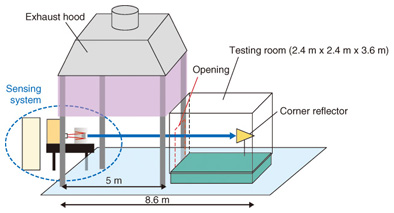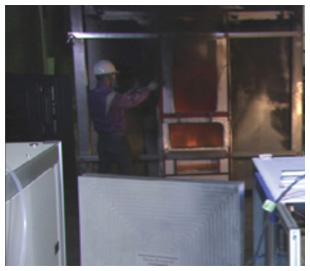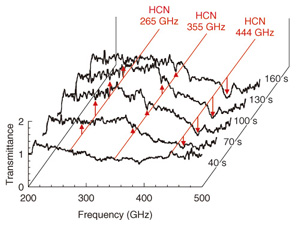 |
|||||||||||||||
|
|
|||||||||||||||
|
Feature Articles: Imaging and Sensing Technologies for Safety and Security Vol. 10, No. 2, pp. 19–24, Feb. 2012. https://doi.org/10.53829/ntr201202fa4 Remote Detection of Hazardous Gases in Full-scale Simulated Fire by Using Terahertz Electromagnetic WavesAbstractThis article describes a prototype spectroscopic sensing system that we have developed for detecting hazardous gases at the scene of a fire from a distance. First, the system's terahertz signal generator and receiver are briefly described. Then, sub-terahertz-band absorption spectra of smoke generated from heated nylon fabric are explained. Finally, a performance test of the developed sensing system carried out in a full-scale simulated fire is presented.
1. IntroductionOur research and development (R&D) activities for detecting hazardous gases from a distance with terahertz electromagnetic waves were previously reported in NTT Technical Review in 2009 [1]. The research began in 2006 and continued under commission from the National Institute of Information and Communication Technology (NICT). At the end of 2010, the last year of the commission, we succeeded in detecting hazardous gases from a distance in a full-scale simulated fire by using a prototype of the terahertz spectroscopic sensing system [2]. In the following sections, we first outline the basic concept of the remote spectroscopic sensing system. We then describe the terahertz signal generator and receiver used in the system. Finally, we present the results of some experiments done with the system: small-scale experiments using a gas cell and large-scale experiments with a full-scale simulated fire. 2. Sensing systemThe operation of the remote gas sensing system is illustrated schematically in Fig. 1. Carbon monoxide, hydrogen cyanide, and other hazardous gases generated by fires have characteristic absorption spectra in the terahertz band. The remote spectroscopic sensing system determines whether or not a hazardous gas is present around the target by sending terahertz electromagnetic waves to the target and analyzing the spectrum of the waves returned from the target. The system requires a terahertz transmitter and terahertz receiver with a wide operating frequency range. To meet the requirement, we used a photomixing technique to generate the terahertz electromagnetic waves. The optical signal generator comprises three laser sources that emit light waves in the 1.5-µm band (Fig. 2). One of the lasers is a tunable-wavelength laser source (TLS); the other two are fixed-wavelength laser sources (FLSs). The signal generated by the TLS is first split and the resulting signals are mixed with the outputs of both FLS1 and FLS2 to generate optical beat signals. Those two optical beat signals are converted into terahertz electromagnetic waves by a uni-traveling carrier photodiode (UTC-PD) module [3]. The FLS wavelengths are set so that there is a 350-MHz frequency difference between them. As a result, the frequency difference of the two generated terahertz electromagnetic waves is 350 MHz and is independent of the wavelength of the TLS. When we use the two terahertz electromagnetic waves as sensing waves and as the local oscillator signal of the heterodyne receiver, the frequency of the heterodyne receiver’s intermediate frequency signal can be made constant at 350 MHz. This means that we do not have to widen the bandwidth of the intermediate frequency circuit needlessly, even if we change the frequency of the terahertz electromagnetic waves very rapidly. Consequently, we can keep the receiver’s noise level very low.
Furthermore, small proportions of the two FLS outputs are extracted and coupled, and their beat signal is obtained. This beat signal is mixed with the reference signal and their frequency error is extracted. This error is fed back as the driving condition of FLS2. Thus, the frequency difference of the FLSs is locked. In this study, the FLS wavelengths were set to near 1548.959 nm, and the TLS wavelength was swept between 1547.3631 nm and 1544.971 nm in less than 1 s. The corresponding frequency sweep was from 200 GHz to 500 GHz. Details of the UTC-PD modules used in this study are given in another Feature Article in this issue [3]. A block diagram of the receiver is shown in Fig. 3. The mixer that we used for heterodyne detection was the superconductor-insulator-superconductor tunneling (SIS) mixer developed by the National Institute of Advanced Industrial Science and Technology [4]. The mixer and the low-temperature amplifier that amplifies the intermediate frequency signal output are inside a mechanical cooler and maintained at the temperature of liquid helium. The terahertz signal used for sensing is combined with the local oscillator signal by a coupler placed just in front of the receiver and then fed to the SIS mixer. The received sensing waves are converted to an intermediate frequency signal by the SIS mixer. After boosting by the low-temperature amplifier, the out-of-band noise is removed and the signal is converted to a voltage signal that is proportional to the signal strength. The voltage signal is acquired by a personal computer via an analog-to-digital converter connected to the detector’s output. The signal is combined with the wavelength data to obtain the spectrum. An overall view of a remote spectroscopic sensing system that comprises the terahertz signal generator, receiver, and optics is shown in Ref. [5]. We performed all of the experiments described below in electromagnetically shielded areas.
3. Transmission spectrum of smokeSmoke from heated nylon fabric was supplied via a heated pipe to a gas cell that was 1 m long and 10 cm in diameter. A photograph of the cell filled with the generated smoke is shown in Fig. 4. The smoke was so dense that it was impossible to see the wall on the other side of the cell. The smoke consisted of a large number of suspended particles with diameters of several micrometers. The wavelength of the terahertz waves used for sensing was about 1 mm, which is two or three orders of magnitude larger than the particles. Accordingly, the sensing waves were not scattered by the particles. That is, such a dense smoke is transparent to the sensing waves. Therefore, we could observe the characteristic absorption spectra of the gases in the smoke when we measured the smoke’s absorption spectra with the developed terahertz electromagnetic waves generator and receiver. The results are shown in Fig. 5. At 240 s and 480 s after the nylon fabric began to be heated, absorption peaks were observed at 265 GHz, 355 GHz, and 444 GHz. Those peak frequencies agree well with the absorption frequencies of hydrogen cyanide molecules. A detailed analysis clarified that the spectrum included the absorption peaks of hydrogen cyanide, acetonitrile, and water [6]. Nylon is an organic polymer that contains amide bonds. Therefore, the observed spectra suggest that the nylon fabric burned incompletely in this experiment.
4. Gas detection in a full-scale fireNext, we present the results of remote gas sensing experiments conducted in a full-scale simulated fire. The setup in the fire test hall at the Center for Fire Science and Technology at the Tokyo University of Science is illustrated in Fig. 6. We put urethane blocks in a testing room and ignited them. The testing room imitates a small room and its inside dimensions are 2.4 m wide, 3.6 m deep, and 2.4 m high. The testing room filled with smoke and gases generated by the fire within a minute after ignition. The remote spectroscopic sensing system was placed 5 m from the testing room and transmitted terahertz waves toward the room’s opening. In this experiment, the terahertz waves were reflected by a metal corner reflector placed on the opposite side of the testing room facing the sensing system. Some of the returned terahertz waves were received by the remote spectroscopic sensing system.
The room’s opening as seen from behind the remote spectroscopic sensing system is shown in Fig. 7. The measured absorption spectra of the terahertz waves are shown in Fig. 8. Absorption peaks were clearly observed at 265 GHz, 355 GHz, and 444 GHz between 70 s and 160 s after ignition. Those frequencies are consistent with the absorption frequencies of hydrogen cyanide molecules. The average value of the hydrogen cyanide concentration estimated from the measured absorption intensity at a time between 100 s and 250 s was 890 ppm. In this experiment, the gas inside the testing room was sampled over the time period between 90 s to 300 s. Chemical analysis of the sampled gas revealed a hydrogen cyanide concentration of 640 ppm, which is consistent with the value obtained by the remote spectroscopic sensing system. These results show that the terahertz remote spectroscopic sensing system succeeded in realtime remote monitoring of hazardous gases generated by a fire.
The main purpose of the experiments reported here was to verify the basic operation of active remote spectroscopic sensing in the terahertz band. We therefore used an artificial metal corner reflector to reflect the terahertz electromagnetic waves effectively. However, this does not mean that such a reflector is always required in actual situations. For example, the intersections of three orthogonal planes at room corners or at a protruding wall also form corner-reflector structures. Such non-metallic corner reflector structures made by the wall’s materials certainly exist on the interior and exterior walls of structures. We believe that terahertz electromagnetic waves of sufficient intensity can be returned when we irradiate such structures with terahertz electromagnetic waves. We have already confirmed that a corner reflector made of concrete panels effectively reflects terahertz waves. 5. Concluding remarksWe have reported on remote detection of hydrogen cyanide in smoke by using terahertz waves. We will continue our investigation and clarify the sensing system’s potential, such as the detectable gas species, detectable minimum gas concentrations, and maximum distance to the target. We will also clarify the needs of emergency responders and develop a more practical remote gas detection system. References
|
|||||||||||||||



















